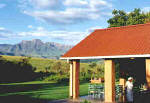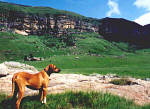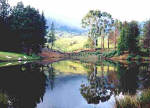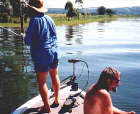|
![]()
It was great to rest up awhile in Jo’burg after a tedious two day flight from Panama City. The lounge room of Rockey Street Backpackers is awash with tourist brochures enticing travellers to all over Southern Africa. I knew roughly where I wanted to go. There were still parts of the Drakensberg I hadn’t seen – tantalizing gaps in my memories of South Africa.
I discussed travel plans with the hostel staff and bought a Baz Bus ticket for Pietermaritzburg, with the intention of stopping off at several places on the way. South African backpacker hostels excel at being travel and tour agents … they know all and will arrange anything.
Early next morning the Baz bus arrived at the doorstep to pick up me and three other travellers. We called in at other Jo’burg backpackers gathering more passengers then headed off south eastward on the N3 for the day’s run to Durban, about 600 kms.
My first choice of stopover was Winterton, a farming village distant from the mountains.
Dairy farms with pigs and chickens alternate with vast fields of soybeans and mealies (maize) and beyond are dry rolling hills covered in prickly acacia shrub, once the battlefields of the past. This region is part of the Battlesfield Route developed for tourists interested in the early conflicts between the British, Boers and Zulus.
A group of five of us did a day trip to the Spioenkop Game Reserve on the shore of a large dam near Winterton. Here they have two hour tours on horseback costing 60 Rand, starting at 8am and 2pm. We followed our African guide at walking pace along a dirt road and across country keeping our distance from a herd of rhinos. What a great view you get from the top of a horse! Wild animals showed no fear of our approach. We saw close up wildebeest, buffalo, zebra, antelope and a pair of giraffes. In 1900, nearby Spioenkop Hill was the site of a bloody battle between the British and Boers in an attempt to relieve the Boer’s siege of a British garrison at Ladysmith.
|
![]()
From Winterton the mountains are 30 kms away. In the Champagne Valley there is excellent accommodation at Ardmore Guest Farm and Ed’s Inkosana Lodge, the ultimate in backpackers where I stayed five days. One gets a magnificent view of the escarpment and Cathkin Peak 3181 m, first climbed 1912. Nearest access for hiking is at Monks Cowl, with nearby Champagne Castle 3377m, being the highest point.
Ed at Inkosana is an experienced mountaineer having climbed in Nepal and the Andes. Now he takes life easy and will arrange trips and transport to his beloved mountains and elsewhere. It is worth staying at Inkosana just to sample his hearty breakfasts and admire the koi carp.
Further on, accessed from Mooi River township, is Mt Lebanon Backpackers. It is isolated, high up the hillside, with splendid views. Ashley and Sandra live in a large farmhouse set above the lodge adjacent to the trout dam. Most of their 500 acre property is leased out for grazing. Ashley has plans to build another lodge and develop horse trailing as a major attraction.
|
![]()
I found it a great place to relax … no television or radio, lots of magazines to read, a dam for fishing and boating, a barbecue and mountain hikes start at the backdoor. Always there are three beautiful Rhodesian Ridgeback dogs watching and waiting to go for a hike with you. They lick you to death with affection!
You can try Sandra’s farmhouse cooking and fraternize at the bar in the evenings. There are six permanent African staff (1 cleaning lady, 3 stable hands, 1 gardener, 1 odd job man) plus casuals employed in the dry season (April- Aug) to prevent veldt fires. It is law to have a 60 meter burnt strip around the farm (and house) as a firebreak. They spray a 100 meter strip and burn it off when dried out.
Ashley has 13 horses, including eight fully grown and five youngsters. One morning he lead five of us on a ride of 20 kms across the valley and back around the escarpment of Mt Lebanon. The baboons howled at us from the rocky crags. I rode Pale Face, a huge 16 hand veteran who lagged behind at the end. It was wonderful but I took a soak in a hot bath to recover!
Trout Fishing
|
![]()
The dam is stocked with rainbow trout, now 12 to 16 inch size. They provided much excitement and a steady supply of hors d’oeuvres, as smoked trout from the barbecue. Suitable fly tackle is a floating line and small feathered lure (Mrs Simpson type) with a swivel or lead shot on the leader to get some depth. They even take macaroni bait on a hand line!
On the other side of Mt Lebanon is the Drakensberg International Backpackers consisting of a beautiful thatched farmhouse set amidst the Mooi River valley. I stayed a few days and fished the dam and river with little success. It caters for groups of students from Durban who like the hippie atmosphere and television. A sideline is the breeding of vicious Boer bull guard dogs which are lovely but not my scene.
|
![]()
To get from one backpacker to the next you use a combination of their transport and the Baz bus. Eventually you will end up at Pietermaritzburg. This is a crossroads. You must decide whether to return to Jo’burg, go on to Durban or take the minibus to Underburg and Sani Pass which has the only road crossing the Drakensberg escarpment.
Pietermaritzburg offers the choice of three backpackers viz., long established Sunduzi run by Brian Dos Santos, Lin’s Earthwalkers, both being converted family homes, and the more upmarket Ngena Lodge located in town.
Bass Fishing
When staying at Sunduzi I enquired of Brian about the local fishing. He obligingly arranged a day’s outing with his mates to go bass fishing on nearby Albert Falls Dam. It was all new to me. Four of us met up at the lake shore. Basil and Filip pushed the “Jim Greene” into the water and we roared off at 100 km per hour to the first hot spot. Owner Bas is a champion bass angler. Match fishing is the game rather than fishing for the pot because the culinary attraction of bass is not high.
|
![]()
Our first stop was mid-lake where some sunken trees provided shelter for bass (also barbel and catfish) in about six meters of water at 25°C temperature, according to the boat’s electronic “fish detector”. A marker buoy was thrown out. Bas stood on the bow and while fishing, controlled with his foot a silent electric motor drive for the boat.
We used bait casting rods with a weighted wobbly plastic lizard as bait, in purple and khaki color. It is very slowly drawn along the bottom. The hook is embedded in the plastic so as not to hang up on weeds. Bas catches several bass and lets them go.
Next we tried the weed beds along the shore. We splashed the lizard close to the rushes, twitched it a few times and let it sink to the bottom where the bass grab it, sometimes! It is quite a knack. Bas out fished us 5 to 1! We kept one fish to cook up at home.
What a memorable day! Especially I was amazed to see a large bass leap a foot out of the water and chomp a dragonfly on the wing!
Back to Jo’burg
Recommended route for the adventurous is to traverse Lesotho from Sani Pass to the capital Maseru. First head for Russell Suchet’s Sani Lodge near Underburg. When hiked out there, ascend the Pass by 4WD vehicle and stay at Sani Top Chalet, the highest pub in Africa (2874m). Passport is needed to enter Lesotho. Allow two days to get to Maseru. Side trips to Malealea Lodge and/or Semonkong Lodge are a must. After Lesotho, rest up awhile at unique Rustlers Valley near Ficksburg then back to jolly Jo’burg. Allow about three weeks for an unforgettable trip.
The Drakensberg, or “Dragon Mountains”, is the name given to the unique mountain escarpment that extends for about 350 kms in the KwaZulu/Natal region of South Africa.
It forms the formidable eastern boundary of the Kingdom of Lesotho which consists for the most part of an isolated highland plateau like Tibet. Only road crossing is at Sani Pass in the southern Drakensberg.
The farmland region adjacent to the Drakensberg is well developed for tourism and known as the Battlefields and Midlands Meander.
How to Get There
Usual entry point to South Africa by plane is Johannesburg, (always called Jo’burg) the gold mining and financial centre and capital of Gauteng Province. Population estimated at 6 million; altitude 1500 metres.
For the international traveller Jo’burg is by necessity a stopping or starting point where you may have to stay a few days. The crime rate is pretty high so to survive intact the tourist must keep a low profile.
Caution
Safe travelling in South Africa is like driving a car …. obey the rules of the road and don’t put yourself in a vulnerable position vis-a-vis the robbers, plus luck being on your side.
Rules of Thumb
I travel by plane and Baz bus or organized tours and avoid bus terminals and railway stations. Definitely no hitchhiking.
If you must visit downtown shopping areas, the safest time is in the morning when muggers tend to be asleep. From midday onwards the activity of robber gangs increases considerably as members become drunk, drugged and short on money. After dark you’re a goner. Don’t become their walking goldmine. Muggers invariably carry knives and often guns. Generally stay indoors after dark and enjoy the hospitality of your backpacker bar etc. Luck?? Well, even backpackers have armed holdups!
Become like a “springbok” … always be on the alert for danger. Make your own decisions. Don’t get drawn into dicey situations by unthinking companions. Follow these road rules and you will find South Africa a wonderful country to visit.
Jo’burg – Where to Stay?
At the airport the Information Center has accommodation details on hotels/backpackers. Get a free copy of “Coast to Coast” a booklet listing all backpackers in Southern Africa. See also VIP Backpackers, Just Backpacking and Hostels.com. Choose one and phone them to get picked up. Try different ones each visit.
To experience life in a wealthy white suburb try the popular Backpackers Ritz which is a castle-like mansion on extensive grounds with swimming pool and close to the Dunkeld West Shopping Center.
The modus operandi of a black suburb can be explored from the Rockey Street Backpackers which is a favorite of mine. It is nearer the airport and is close to shopping and an excellent Internet Cafe.
Mostly dorm accommodation is available with some doubles. Cost from US$6.50 dorm and up to $10 each for double room. Rand rates are linked to the US dollar. All have kitchen facilities (and bar) so buy your food at a local supermarket. Often meals are available on request and on Sunday evening a barbecue (braai) is customary.
Drakensberg – Where to Stay?
All places and tour agents are listed in the Backpacker’s Guide – Kwazulu-Natal; also see individual links in text.
Transport
For safety and convenience, use the wonderful Baz Bus which caters solely for backpackers along the main route of Jo’burg – Durban – Port Elizabeth – Cape Town, with northern extensions to Victoria Falls and Swaziland.
Buy your ticket at your backpackers and hop on and off when you like at any place en route. The driver will phone ahead on his mobile so that you get picked up at your stop off point. They use modern Mercedes buses with trailer and capacity of up to 22 passengers. A great way to meet other DIY travellers.
A shuttle, or minibus connects Pietermaritzburg with Underburg and so to Sani Lodge and Sani Pass.
Weather
The southern summer is December thru February with day temps 20 to 25 °C in the Midlands. Along the base of the Drakensberg, at altitudes of 1000 to 1500 meters, expect cooler temps with snow on the tops in wintertime. Check weather now for Ladysmith and Pietermaritzburg (PMB).
Exchange Rate
Presently US$1 equals 6.5 Rand, but check the rate today.
The Author

You can visit Allano’s web site by clicking here.





